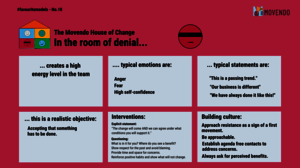#favouritemodel No.18 - House of Change - Denial

In this room, an inner attitude of " against change" is dominant; people who are in this scene usually have not accepted the necessity or the meaning of the impending change yet, or have clear doubts about it. With the lasting positive emotions of the " room of contentment", an attitude ranging from self-confidence to arrogance and even ignorance might still be dominant. People in the room usually say things like:
- "Not another change!"
- "Management simply doesn't understand our business."
- „They are making a big fuss again.”
The emotional state of anger, despair and rejection can often be observed in actions such as: a partly aggressive defense of the past and present; ignoring information coming from the outside; glossing over facts and figures or emphasizing past successes.
How does this #favouritemodel help you?
To support your employees on their journey through the "room of denial" to the next room, it is necessary to enable a basic acceptance of the change. At this point, denial and resistance are natural and normal reactions to change. It is important for ou to allow and value these forms of emotionality in your team. If you perceive resistance, you know that those involved are beginning to deal with the change and have actually moved out of the room of contentment. It is more critical if you do not sense any resistance at all.
If everyone involved is aware of this normality, it will also be easier to face these emotions in the future and then move on to the next room, the room of confusion.
From a systemic perspective, overcoming denial and resistance cannot be controlled from the outside. As a leader, it is therefore your task during this phase to support the individual decision-making process.
For example can you encourage your colleagues by using a coaching approach in which you ask questions such as "How will this change be personally beneficial to you?" and allow the employee time to develop his or her own answers. It is also important to strike a balance between respecting the past and sending a clear message that change is necessary and will happen. Clearly state the team's scope for co-design and involve those affected in shaping the specific change. The more design options employees have, the more likely they are to move into the next room, the "room of confusion," where acceptance for the change dominates and employees clearly say "yes" to the change.
At the same time, as a leader, you are also part of the change. Therefore, it is important to give yourself the same space for emotions as your colleagues. In the best case, you are already ahead in the process, but this does not have to be the case. As much as your co-workers need you to provide clear direction in the " room of denial," you yourself may equally need it. Therefore, the recommendation is that you discuss your personal emotions and doubts on your part with your own leader. It is important to be an authentic leader to your team, at the same time it is not very helpful in the " room of denial" if you join your team to form a "resistance group". Have the attitude and capacity to lead yourself and be available to your employees as an agent for answers.











